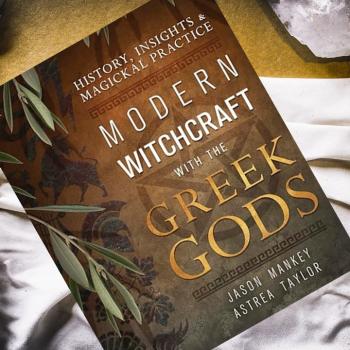As a transwoman, I have often wondered if there were others like me in Ancient Mythology. Were there ancient deities who were trans, non-binary, or gender non-conforming? Turns out there were. Ancient Greece had a prominent culture of gender fluidity, as did many other ancient societies.
Aphroditus was sometimes referred to as the male form of Aphrodite. Statues of him showed him with a female figure, breasts, narrow waist, long hair, women’s clothing, but also with a penis and testes. He is said to have originated on the island of Cyprus, and arrived in Athens in the 4th century BCE. He was sometimes celebrated there in transvestite rites. It is said the festivals allowed “women to act the part of men, and men to put on woman’s clothing and play the part of women” (from Wikipedia). He was definitely gender non-conforming.

Hermaphroditus was the son of Hermes, messenger of the gods, and Aphrodite, Goddess of love. His name is a combination of both of his parents. From Wikipedia: “According to Ovid, he was born a remarkably handsome boy with whom the water nymph Salmacis fell in love with and prayed to be united forever. The gods granted the request, so that he and the nymph became united in such a manner that the two could not be called a man or a woman, but were both” (Metamorphoses IV, pp. 274-388 , 8 AD). Hermaphroditus is the god of hermaphrodites and effeminates. I believe in today’s society, Hermaphroditus would be a modern day pre-operative transwoman.
Loki, a Norse god, also called the trickster god, would many times disguise himself as a woman. Some myths said that Loki was bisexual. Loki was an accomplished shape-shifter and according to legend has also appeared as a salmon, a mare, a fly, and of course a woman.

Ovid’s Metamorphoses (Met. 9, pp. 666-797) mentions Iphis and Ianthe. Iphis was born a girl, but her mother passed her off as a boy so that she wouldn’t be killed. The name was fitting for a boy and a girl, so that wasn’t too much of a problem. According to the myth, Iphis as a 15 year old boy, fell in love with another girl, Ianthe. Iphis’s mother appealed to the Goddess Isis for help. Isis transformed Iphis into a male before Iphis and Ianthe got married. I believe this may have been the first sex change. At least they ended up happily ever after according to the myth.
Ikapati was a Great Mother Goddess of the Tagalog society in the Philippines. She was a protector of crops, animals that were domesticated and, according to myth, gave mankind agriculture. It was said that she appeared many times dressed in male clothes. This would have made sense as she was frequently seen in the fields. In many indigenous cultures, including in the Americas, it was accepted that more than two genders were socially and spiritually accepted. These gender non-conforming individuals were seen as people who were very spiritual, and many became leaders and healers in their societies. In Native American culture, many who were called two-spirit became shamans.

Ometeotl was an Aztec God of duality. He was considered both male and female, using the names Ometecuhtli and Omecihuatl. He had an equivalent god in Mayan mythology, Itzamna, who identified with Hunab Ku, an invisible god. Both gods could be considered self-created gods according to myth. Ometeotl was to the Aztecs the idea that their Universe consisted of dark and light, night and day, order and war, and things like that.
I’m of the opinion that if more people would understand that there are more than binary people in this world, it would be a better and safer place for all. I think the ancients got it right in their beliefs. People were just human beings, and not judged only on their biological sex. A good book to consider reading is this excellent book by Gerald N. Callahan, PhD., Between XX and XY: Intersexuality and the Myth of Two Sexes. From the book: “On October 10, 1970, the day she was born, she was named Dorothy Maree Alaniz–a baby girl. Curiously, though, no one filled out a birth certificate that day. When the certificate was finally filed on November 5, the name on it was Rudolph Andrew Alaniz. Within less than one month after her birth, this girl became a boy.” The book is available from Amazon and other book sources.
I created this blog article as part of my training in Hekate’s Modern Witchcraft. It’s a one year and one day course from www.keepingherkeys.com


















